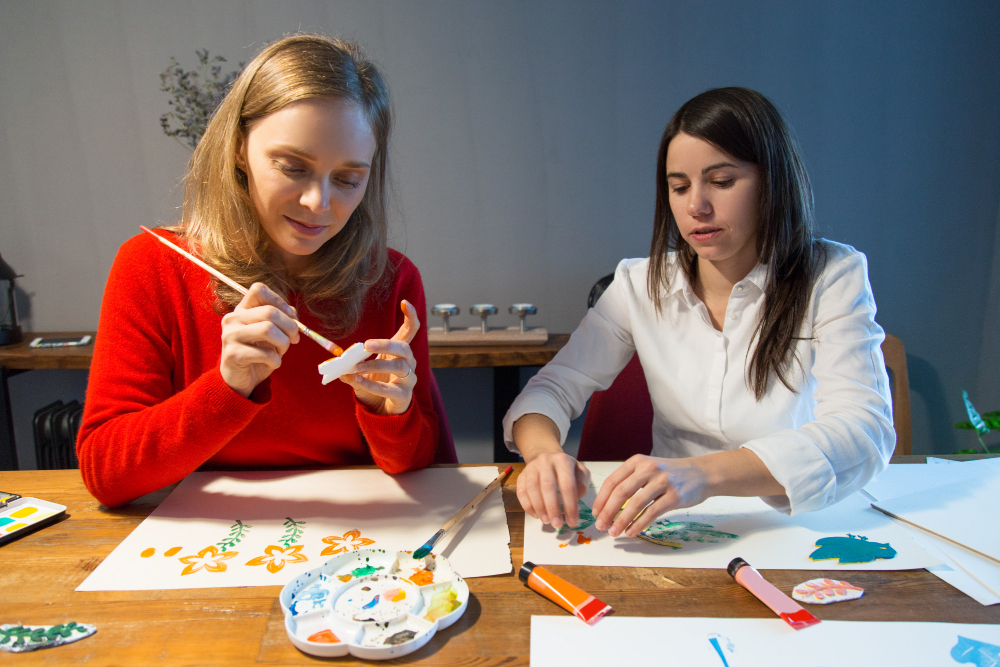Unlocking Creative Healing Pathways
Art therapy encompasses a wide range of techniques and approaches, each tailored to meet the unique needs and goals of individuals seeking therapeutic support. These techniques harness the power of artistic expression to facilitate emotional processing, self-discovery, and healing. In this guide, we’ll explore various art therapy techniques and methods used by certified art therapists.
Gestalt Art Therapy:
- Embracing the Present Moment: Gestalt art therapy focuses on the here and now, encouraging clients to explore their immediate experiences and emotions.
- Expressive Materials: Clients choose art materials that resonate with their feelings and use them spontaneously.
- Dialogue with Art: The therapist guides clients in exploring their artwork and engaging in a dialogue with their creations to gain insight.
Person-Centered Art Therapy:
- Self-Expression and Self-Discovery: Person-centered art therapy emphasizes the individual’s self-expression and self-discovery.
- Supportive Environment: The therapist creates a safe and non-judgmental space for clients to explore their emotions.
- Art as Communication: Clients use art to express their thoughts and feelings, gaining a deeper understanding of themselves.
Analytical Art Therapy:
- Exploring Symbolism and Meaning: Analytical art therapy delves into the symbolism and meaning behind the artwork, allowing clients to uncover hidden emotions and insights.
- Dream Analysis: Clients may explore their dreams through art to better understand their subconscious thoughts and emotions.
- Metaphor Interpretation: The therapist guides clients in interpreting metaphors and symbols present in their art.
Art Journaling:
- Reflective Self-Exploration: Art journaling combines visual art with written reflection, providing a structured yet creative way to process emotions and thoughts.
- Mixed Media: Clients use a combination of drawing, painting, collage, and writing to create in their journals.
- Thematic Prompts: Therapists may provide prompts or themes to inspire exploration and self-reflection.
Sculpture and 3D Art:
- Physical Expression: Sculpture and 3D art techniques allow clients to engage with materials in a tactile way, providing a unique channel for emotional expression.
- Clay Work: Creating sculptures from clay can be particularly therapeutic, as clients mold and shape their emotions into tangible forms.
- Assemblage: Clients assemble found objects to convey emotions and stories through the creation of 3D art.
Mandalas and Symmetry:
- Finding Balance and Harmony: Mandalas are circular geometric patterns that can be filled with colors and shapes, offering a sense of symmetry and balance.
- Mindful Coloring: Clients create mandalas through mindful coloring, allowing for relaxation and meditation.
- Symbolic Expression: Mandalas can be filled with symbols or colors that represent specific emotions or themes.
Phototherapy:
- Capturing Moments and Emotions: Phototherapy combines photography with therapeutic exploration, allowing clients to visually document their experiences and emotions.
- Photo Journals: Clients take and curate photographs that represent their feelings, experiences, and personal narratives.
- Visual Storytelling: Photos are used to tell stories and explore personal narratives with the guidance of a therapist.
Narrative Art Therapy:
- Visual Storytelling: Narrative art therapy helps clients create visual narratives through art, enabling them to explore and reframe their personal stories.
- Sequential Art: Clients use a series of images or drawings to represent the progression of their experiences or emotions.
- Reimagining Narratives: The therapist guides clients in reshaping and reinterpreting their life stories through visual storytelling.
Digital Art Therapy:
- Exploring Technology and Creativity: Digital art therapy harnesses digital media and technology to provide new avenues for artistic expression.
- Tablet and Software: Clients use digital tablets and software to create digital art, allowing for experimentation with colors, shapes, and textures.
- Collaborative Projects: Online platforms enable clients to engage in collaborative digital art projects with others in a therapeutic context.
Nature-Based Art Therapy:
- Connecting with the Environment: Nature-based art therapy encourages clients to create art in natural settings, fostering a connection with the environment.
- Land Art: Clients use natural materials found in outdoor settings to create temporary art installations.
- Eco-Art Therapy: Art therapists incorporate nature into the therapeutic process, whether through outdoor art-making or discussions about the natural world.
Art therapy techniques offer a diverse array of options for individuals seeking creative pathways to healing and self-discovery. These methods, guided by trained art therapists, allow clients to explore their emotions, thoughts, and experiences through various forms of artistic expression. Whether it’s through painting, sculpture, photography, or digital media, art therapy empowers individuals to unlock their inner worlds and embark on journeys of emotional and psychological growth.

Jass
Jass earned her bachelor’s degree in Computer Science, transitioning into a profession as a content writer. With a keen mastery of words, she takes pleasure in expressing her thoughts and ideas creatively. Her ability to captivate audiences with her imaginative write-ups stands out as one of her notable strengths.



